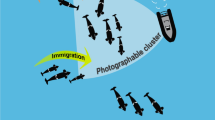Abstract
Social network analysis has become a popular tool for characterising the social structure of populations. Animal social networks can be built either by observing individuals and defining links based on the occurrence of specific types of social interactions, or by linking individuals based on observations of physical proximity or group membership, given a certain behavioural activity. The latter approaches of discovering network structure require splitting the temporal observation stream into discrete events given an appropriate time resolution parameter. This process poses several non-trivial problems which have not received adequate attention so far. Here, using data from a study of passive integrated transponder (PIT)-tagged great tits Parus major, we discuss these problems, demonstrate how the choice of the extraction method and the temporal resolution parameter influence the appearance and properties of the retrieved network and suggest a modus operandi that minimises observer bias due to arbitrary parameter choice. Our results have important implications for all studies of social networks where associations are based on spatio-temporal proximity, and more generally for all studies where we seek to uncover the relationships amongst a population of individuals that are observed through a temporal data stream of appearance records.






Similar content being viewed by others
References
Aplin LM, Farine DR, Morand-Feron J, Cole EF, Cockburn A, Sheldon BC (2013) Individual personalities predict social behaviour in wild networks of great tits (Parus major). Ecol Lett 16:1365–1372
Barthelemy M, Barrat A, Pastor-Satorras R, Vespignani A (2005) Characterization and modeling of weighted networks. Physica A 346:34–43
Beijder L, Fletcher D, Brager S (1998) A method for testing association patterns of social animals. Anim Behav 56:719–725
Cairns SJ, Schwager SJ (1987) A comparison of association indices. Anim Behav 35:1454–1469
Croft DP, James R, Krause J (2008) Exploring animal social networks. Princeton University Press, Princeton
Danon L, Diaz-Guilera A, Duch J, Arenas A (2005) Comparing community structure identification. J Stat Mech-Theory Exp 09, P09008
Farine DR, Garroway CJ, Sheldon BC (2012) Social network analysis of mixed-species flocks: exploring the structure and evolution of interspecific social behaviour. Anim Behav 84:1271–1277
Franks DW, Ruxton GD, James R (2010) Sampling animal association networks with the gambit of the group. Behav Ecol Sociobiol 64:493–503
Freeman LC (1979) Centrality in social networks. I: conceptual clarification. Soc Networks 1:215–239
Garroway CJ, Radersma R, Hinde CA (2015) Perspectives on social network analyses of bird populations. In: Krause J, Croft DP, James R (eds) Animal social networks: perspectives and challenges. Oxford University Press, Oxford, pp 171–183
Gibbons JW, Andrews KM (2004) PIT tagging: simple technology at its best. Bioscience 54:447–454
Ginsberg JR, Young TP (1992) Measuring associations between individuals or groups in behavioural studies. Anim Behav 44:377–379
Girvan M, Newman MEJ (2002) Community structure in social and biological networks. Proc Natl Acad Sci USA 99:7821–7826
Gossler A (1993) The great tit. Hamlin, London
Hinde R (1952) The behaviour of the great tit (Parus major) and some other related species. Behav Suppl 2:1–201
James R, Croft DP, Krause J (2009) Potential banana skins in animal social network analysis. Behav Ecol Sociobiol 63:989–997
Krause J, Krause S, Arlinghaus R, Psorakis I, Roberts S, Rutz C (2013) Reality mining of animal social systems. Trends Ecol Evol 28:541–551
Lahti K, Koivula K, Orell M (1997) Dominance, daily activity and winter survival in willow tits: detrimental cost of long working hours? Behaviour 134:921–939
Newman MEJ (2010) Networks: an introduction. Oxford University Press, Oxford
Perrins CM (1979) British tits. Collins, London
Psorakis I, Roberts SJ, Rezek I, Sheldon BC (2012) Inferring social network structure in ecological systems from spatio-temporal data streams. J R Soc Interface 9:3055–3066
Rutz C, Burns ZT, James R, Ismar SMH, Burt J, Otis B, Bowen J, St Clair JJH (2012) Automated mapping of social networks in wild birds. Curr Biol 22:R669–R671
Saitou T (1978) Ecological study of social organization in the great tit Parus major L. I. Basic structure of winter flock. Jpn J Ecol 28:199–214
Smyth B, Nebel S (2013) Passive integrated transponder (PIT) tags in the study of animal movement. Nat Educ Knowl 4:3
Wasserman S, Faust K (1994) Social network analysis: methods and applications. Cambridge University Press, Cambridge
Watts DJ (1999) Small worlds: the dynamics of networks between order and randomness. Princeton University Press, Princeton
Whitehead H (2008) Analyzing animal societies. The University of Chicago Press, Chicago
Whitehead H, Dufault S (1999) Techniques for analyzing vertebrate social structure using identified individuals: review and recommendations. Adv Stud Behav 28:33–74
Wilson EO (1975) Sociobiology: the new synthesis. Harvard University Press, Cambridge
Acknowledgements
We thank J. Howe, T. Wilkin, S. Evans, A. Hinks and A. Grabowska for assistance in the field and three anonymous reviewers for valuable comments on the manuscript. This research was funded by an ERC grant to BCS (AdG 250164) and a Microsoft Research Grant to IP. LMA was also funded by an Australian Postgraduate Award and by an International Alliance of Research Universities travel grant.
Ethical standards
All authors declare that the present study complies with the current laws in the UK.
Author information
Authors and Affiliations
Corresponding author
Additional information
Communicated by D. P. Croft
Electronic supplementary material
Below is the link to the electronic supplementary material.
ESM 1
(PDF 566 kb)
Rights and permissions
About this article
Cite this article
Psorakis, I., Voelkl, B., Garroway, C.J. et al. Inferring social structure from temporal data. Behav Ecol Sociobiol 69, 857–866 (2015). https://doi.org/10.1007/s00265-015-1906-0
Received:
Revised:
Accepted:
Published:
Issue Date:
DOI: https://doi.org/10.1007/s00265-015-1906-0




